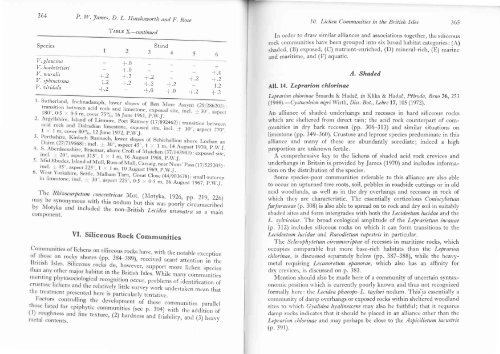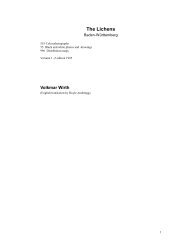Lichen communities in the British Isles: A preliminary conspectus
Lichen communities in the British Isles: A preliminary conspectus
Lichen communities in the British Isles: A preliminary conspectus
You also want an ePaper? Increase the reach of your titles
YUMPU automatically turns print PDFs into web optimized ePapers that Google loves.
364 P. W. James, D. L. Ilazpksworth and F. Rose<br />
'Iasrn X_cont<strong>in</strong>ued<br />
Species Stand<br />
V. glauc<strong>in</strong>tt<br />
V. hochstetteri<br />
V. muralis<br />
V. sph<strong>in</strong>ctr<strong>in</strong>a<br />
V. airidula<br />
-)- ',<br />
1.2<br />
_L)<br />
J-.0<br />
+.0<br />
)- ')<br />
_J- ')<br />
-l?<br />
-)_ )<br />
+,0<br />
-L)<br />
+.0<br />
1. '.)<br />
-L?<br />
+.0<br />
+.2<br />
1.2<br />
t)<br />
1. Su<strong>the</strong>rland, lnchnadamph, lowcr slopes of<br />
transition between acid rock u"a ti-".ton.,<br />
e 1961, r.w .J .<br />
Ramsey (17 1992462): transition beru,ee n<br />
exposed site, <strong>in</strong>cl. + 10., aspect 270o,<br />
.w.J.<br />
ove Lochan an<br />
st 1.970, p.W.J.<br />
): exposed sitc,<br />
Carsaig, near Nuns.pass (l 7/525205);<br />
ust 1969, p.W.J.<br />
, Great Close (44/90367g): smalt outcrop<br />
, 0.5 x 0.5 m, 16 August 1967, p.\N.I:<br />
centricae Mot. (Motyka, 1926, pp. 219, 226)<br />
this nodum but this was poorly circumscribe.l<br />
<strong>the</strong> non-<strong>British</strong> Leciclea'nioeiatra as a ma<strong>in</strong><br />
VI. Siliceous Rock Communities<br />
have, with <strong>the</strong> notable exception<br />
received scant attention <strong>in</strong> thc<br />
ever, support more lichen species<br />
ish <strong>Isles</strong>. While many <strong>communities</strong><br />
occur, problems of identification of<br />
survey work undertaken mean that<br />
ularly tentative.<br />
t of <strong>the</strong>se <strong>communities</strong> parallel<br />
(see p. 304) with <strong>the</strong> ac{dition of<br />
rdness and friabilitl, and (3) heavy<br />
10. <strong>Lichen</strong> Communilies <strong>in</strong> <strong>the</strong> <strong>British</strong> <strong>Isles</strong> 365<br />
In order to draw similar alliances and associations toge<strong>the</strong>r, <strong>the</strong> siliceous<br />
rock <strong>communities</strong> have been grouped <strong>in</strong>to six broad habitat categories: (A)<br />
shaded, (B) exposed, (C) nutrient-enriched, (D) m<strong>in</strong>eral-rich, (E) mar<strong>in</strong>e<br />
and maritime, and (F) aquatic.<br />
All. 14. Leprarion chlor<strong>in</strong>ae<br />
A. Shaded<br />
Leprarion chlor<strong>in</strong>ae Smarda & Hadad, <strong>in</strong> Klika & Hadad, Pffuoda, Bnto 36,253<br />
(1944).-Cystocoleion nigriWirth, Diss. Bot., Lehre 17,105 (1972).<br />
An alliance of shaded underhangs and recesses <strong>in</strong> hard siliceous rocks<br />
which are sheltered from direct ra<strong>in</strong>; <strong>the</strong> acid rock counterpart of <strong>communities</strong><br />
<strong>in</strong> dry bark recesses (pp.306-313) and similar situations on<br />
limestone (pp. 349-360). Crustose and leprose species predom<strong>in</strong>ate <strong>in</strong> this<br />
alliance and many of hese are abundantly sorediate; <strong>in</strong>deed a high<br />
proportion are unknown fertile.<br />
A comprehensive key to <strong>the</strong> lichens of shaded acid rock crevices and<br />
underhangs <strong>in</strong> Brita<strong>in</strong> is provided by James (1970) and <strong>in</strong>cludes <strong>in</strong>formation<br />
on <strong>the</strong> distribution of <strong>the</strong> species.<br />
Some species-poor <strong>communities</strong> referable to this alliance are also able<br />
to occur on upturned tree roots, soil, pebbles <strong>in</strong> roadside cutt<strong>in</strong>gs or <strong>in</strong> old<br />
acid woodlands, as well as <strong>in</strong> <strong>the</strong> dry overhangs and recesses <strong>in</strong> rock of<br />
which <strong>the</strong>y are characteristic. The essentially corticolous Coniocybeturn<br />
furfuraceae (p. 308) is also able to spread on to rock and dry soil <strong>in</strong> suitably<br />
shaded sites and form <strong>in</strong>tergrades with both <strong>the</strong> Lecideetum lucidae and <strong>the</strong><br />
L. syloicolae. The broad ecological amplitude of <strong>the</strong> Leprarietum <strong>in</strong>canae<br />
(p. 312) <strong>in</strong>cludes siliceous rocks on which it can form transitions to <strong>the</strong><br />
Lecideetum lucidae and Racodietum rupestris <strong>in</strong> particular,<br />
The Sclerophytetum circumscriptae of recesses <strong>in</strong> maritime rocks, u'hich<br />
occupies comparable but more base-rich habitats than <strong>the</strong> Leprarion<br />
chlor<strong>in</strong>ae, is discussed separately below (pp. 387-388), while <strong>the</strong> heavymetal<br />
requir<strong>in</strong>g Lecanoretum epanorae, which also has an aff<strong>in</strong>ity for<br />
dry crevices, is discussed on p. 383.<br />
Mention should also be made here of a community of uncerta<strong>in</strong> syntaxonomic<br />
position which is currently poorly known and thus not recognizecl<br />
formally here: <strong>the</strong> Lecidea phaeops-L. taylori nodum. This'is essentially a<br />
community of damp overhangs oi .*pot.d rocks lvith<strong>in</strong> sheltered woodland<br />
sites to which Gyalidea hyal<strong>in</strong>escens may also be faithful; that it requires<br />
damp rocks <strong>in</strong>dicates that it should be placed <strong>in</strong> an alliance othcr than <strong>the</strong><br />
Leprarion chlor<strong>in</strong>ae and may perhaps be close to l\e Aspicilietum lacustris<br />
(p. 3e1).





